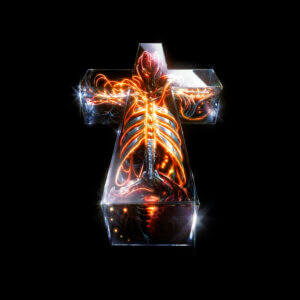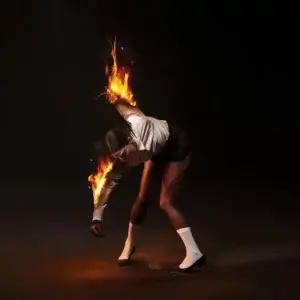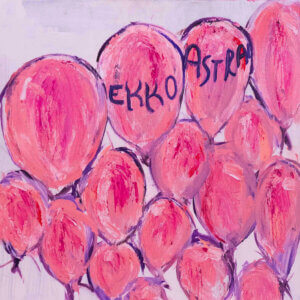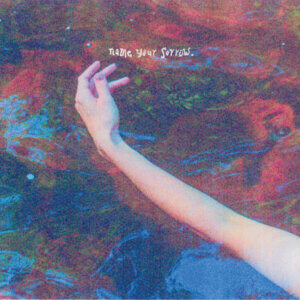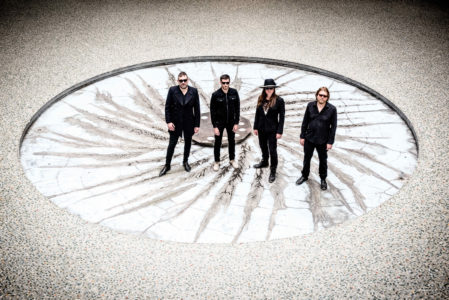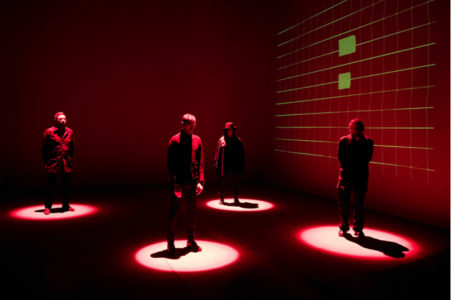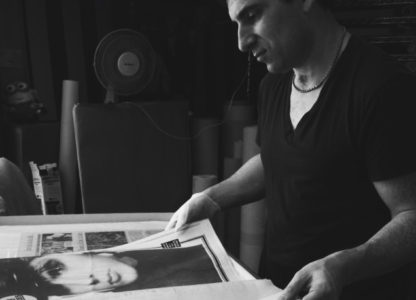Interview with Duran Duran archivist and author Andy “Durandy” Golub
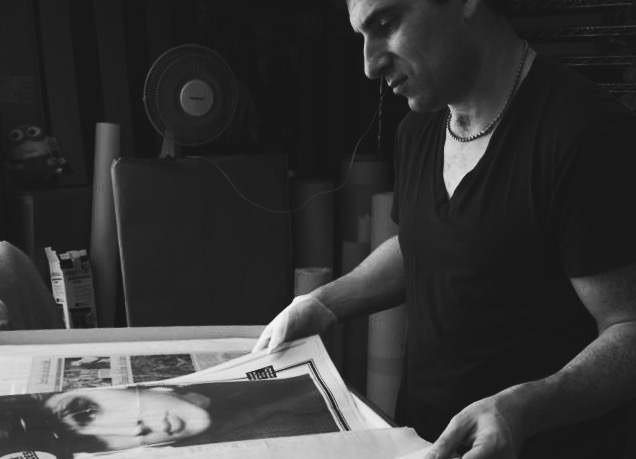
As a compliment to Duran Duran Appreciation Day, August 10 marked the release of Andy Golub’s latest book, The Music Between Us. It is a collection of concert posters, handbills and advertisements documenting moments from Duran Duran’s tour history, accompanied by anecdotes from concert-goers. The Music Between Us is the follow-up to Golub’s 2013 fan favourite, Beautiful Colours: The Posters of Duran Duran. Affectionately known as “Durandy” by fans and band alike, the images from Golub’s books are borrowed from his extensive archive of Duran print material and memorabilia.
The Duran Duran archive itself is an example of how one person’s admiration can translate into action. In essence, it is a work of art with many collaborators, and Durandy as curator and keeper.
Northern Transmissions had the pleasure of interviewing Andy “Durandy” Golub on the significance of the archive, his curatorial work with The Music Between Us, and the enduring romance of Duran Duran.
x
Northern Transmissions: Congratulations on the release of The Music Between Us. It has been a few years since your previous book. Did you take a break in between, or have you been working on The Music Between Us steady since publishing Beautiful Colors?
Andy Golub: I jumped into The Music Between Us. At first it was a much smaller vision; I was just wanting to release something online, just to see what it would look like. Before I knew it, I was mining the archive for material, and I ended up with so much. I decided to link them up with memories from people, and people just started opening up. I realized I couldn’t keep it to a pathetic online Blurb, which was the platform I was using. I also quickly realized that one of the biggest selling points behind the first book was that people loved the presentation … It was a branding. When people got [Beautiful Colors] they knew it was from Durandy Productions. I realized I needed to maintain the quality of production … and that was absolutely essential representing the band and representing myself. I needed to notch up [The Music Between Us] to the same level of the first book, and I’m happy I did.
NT: Where did you find the Duranie anecdotes? Where these people that approached you with their stories, or did you seek them out?
AG: Fans would frequently see me posting requests for memories about certain shows. With the new book, I had a tight focus. Any memories that came in had to be attached to images that I have in the archive. … When people responded with their memories I would ask them how they felt when they were at the show, and most fans are used to just reporting about what happened at the show. They would report about what Simon [Le Bon] did or what songs [Duran] played. I would back up and say, “Look, this isn’t so much about the band or what happened, this is about what you felt.” That stopped people dead in their tracks. They really had to consider what it was that passed through them [at concerts]. People would talk about how they felt like they belonged to a tribe or community of people who understood them. … And a lot of the memories weren’t just joyful, there were also a lot of stories about heartbreak. All of that floods back when people hear certain songs. These are the things [The Music Between Us] is full of.

Duran Duran Concert Poster from 1981, courtesy of Andy “Durandy” Golub
NT: One of my favourite anecdotes is right near the beginning when Julia Prestbury recounts a story of lending, and then selling her belt to Simon Le Bon in Manchester in 1981. Although that would have been at the beginning of Duran’s career, I love how mundane and beautiful that story is. The band seems really approachable through these anecdotes.
AG: Absolutely. Some of the most telling accounts of fandome come from those who saw the band in their formative years. I tried to expand those memories a bit, and talk about the insides of the venues a little bit more. I mean, how often do you really hear about those memories, from way back when the band was just learning and practicing their material as supporting acts? … There is a lot about the band that has nothing to do with what’s going on onstage, but rather what’s happening in the audience. In many ways, what I have done with the archive is just as much about that, than preserving the band’s history.
NT: There is a term for an archive that is constantly re-contextualized for creative purposes: “living archive.” But within that term, there is also the implication of memory. Memory can be incredibly fallible and bias. Have you ever considered or worried about the fact that the Duranie anecdotes may be inaccurate or remembered differently?
AG: Every single fan goes to a Duran show — or the archive — with their own histories and their own interpretations. There’s one level where we all know where we were when Duran Duran came out with a certain single or album. … There are different experiences, but they have common threads. Memory after memory. People have similar emotions towards songs, the same ones as people in whole other countries. I see that when people come to the archive. The archive is a documentation of the band’s milestones, but it is “living” in the sense that the band is still ongoing. I’m adding things all the time. When fans come to the archive, there is an element of something alive there. The memorabilia come to life. It’s something much bigger than the band itself. [Duran Duran] are musicians, but they may not have the time or inclination to let in the grand scope of what they’ve created, and how much it has changed peoples’ lives. That goes back to the book — the idea that [The Music Between Us] could actually be a very small window for the band to learn how audiences experience their shows.

Duran Duran Concert Poster from 1981, courtesy of Andy “Durandy” Golub
NT: In The Music Between Us, there are dozens of subtle and direct anecdotes about romance. Especially in the later stories, people talk about revisiting their initial love of Duran Duran more recently at concerts with their life partners. Aesthetically, Duran started off in the style of New Romantics, but through every style shift their lyrics and videos remained sexy and suggestive. Do you think the romance of the band and the way love and intimacy stirs nostalgia has contributed to the longevity of Duran Duran?
AG: Absolutely. At its heart, Duran Duran is a romantic band. A lot of fans have grown up and experienced love or sexuality for the first time with the onset of videos, like the video for “Girls On Film.” Duran has a very strong sexual identity in their marketing. As they evolved, they grew up and got families, and the fans grew with them, experiencing much of the same transitions. Now you have people with spouses and families, and they are introducing the band to a whole new generation, to their children. … There is a lot of love and affection between the band and the fans. You can almost measure it. In the lyrics, especially with the current album, there is huge talk about timeless love and issues of mortality — like the songs “The Universe Alone” or “What Are The Chances?” Simon’s lyrics are deeper and more thought-provoking than ever, and they hark back to the poetry Simon wrote in the ’80s. All this really contributes to the romance of Duran Duran. They never turned [their music] into a nostalgia thing, so there is a respect earned between the band and their fans.
NT: While collecting and looking through these handbills, flyers and ads, have you identified particular shifts in the promotion of Duran Duran, or commonalities or differences in the ways certain countries represent the band?

Duran Duran Concert Poster from 2008, courtesy of Andy “Durandy” Golub
AG: I have seen some commonalities. They were much more evident in the ’80s when the band had a stronger hand in approving all the marketing, whether it was Malcolm Garrett’s design or another. Nick Rhodes and John Taylor were particularly involved. Duran started out as an art band, and the earliest advertisements were just run on copiers, designed by themselves. As the band has switched their focus to the live shows and raised production values, I think there has been a discernible shift in the band’s marketing. A lot of the design work has been handed off to the promotors. … I feel like it’s been a bit of a loss, to be completely honest. … Countries [outside of North America] are often willing to take more chances with how they promote the band, which has been really cool. Italy and Argentina especially have incredibly loyal followers, and I think the promotors play on that. There are posters on the streets, huge subway posters, and on the sides of buildings, and a lot of them have the band’s faces on them. I think there is a huge difference between having a poster with basic promo text, versus having the band’s faces. It really strengthens the connection with fans.
And that actually leads into why I feel that with every year, what I do becomes more valuable. All the promotional content is meant to have very short lifespans. Posters are up for one day and disappear. A lot of venues even have policies to destroy posters after a certain amount of time. Everything I do is a race against time, especially in other countries. Transcending language barriers and cultural differences, the fans have really banded together to look for posters for me.

Photo courtesy of Andy “Durandy” Golub
NT: You are a prolific collector of Duran Duran paraphernalia and memorabilia, print and otherwise. Practically, how do you archive these items?
AG: The archive is housed in a 10′ x 20′ space. It is temperature-controlled. I have elements introduced to draw moisture out of the air. There is an archival standard with containment. I have invested just as much in archival supplies as I have in memorabilia. I can laugh at it, but there is really no compromising when we’re talking about the life span of paper material. Paper is organic. It absorbs its environment. I often get memorabilia from houses where there isn’t much thought into archiving, and I have to put it through a quarantine period — keeping it in acid-free tissue and letting it air out. Some posters, especially bigger posters, have been shipped off to my poster doctor, Danny Steward, who I’m sad to say passed away this year. He was a real mentor. He would mount larger posters onto acid-free linen, and then restore them. It was a long and intense process with beautiful results. It is a constant vigilance that I maintain the archive, assess the condition of the archive, and repair anything that I can.
NT: What is the copyright around the material you collect, and then publish? How did you secure the rights for these posters, handbills and flyers?
AG: The first book was more of an issue because I was dealing with official promotions that came from record companies, and I worked closely with Duran’s management to secure rights. A lot of the material in the new book hail from publications that are either unknown or no longer in circulation. I really tried to identify and obtain the rights, but sometimes it’s just not possible. A lot of these [images] are from unofficial sources. I believe everything has been secured that needs to be. I go into this with my eyes open.
NT: Do you have plans for another book? And if so, what sort of content are you thinking of showing?
AG: I’m always thinking about the next thing. I would love to do books that focus on the band members’ personal endeavours. Simon’s been involved in different benefits and performances, and his own yacht racing; John has had The Power Station and his solo career; Nick has had photography; and Roger [Taylor] has had his DJ sets across the world, and especially in Italy. The posters that I have [from those periods] are such that nobody has ever seen. … I haven’t announced this publicly yet, but I have sought out a publisher for the first book and signed a contract. They want to represent the first book and additional publishing. I will be turning my attentions to that later this year. I would never have imagined, and my parents wouldn’t have ever imagined, that I would get as much mileage out of this passion as I have.
NT: What are your five favourite albums, not necessarily Duran Duran?
AG: This is where I can probably be accused of having tunnel-vision. I have learned about music beyond Duran from my fiancée. When it comes to entire albums, I think Duran have been the ones that have given me collections of songs that I love so much:
Duran Duran — Seven and the Ragged Tiger
Duran Duran — Rio
Duran Duran — Duran Duran (first album)
Duran Duran — Notorious
Duran Duran — All You Need Is Now
…But I do love all kinds of music, from jazz to country. I’m more well-rounded than people expect. But when it comes to what really takes me into the stratosphere, it’s gotta be the Fab Five.
Interview by Brit Bachmann.
Latest Reviews
Tracks
Advertisement
Looking for something new to listen to?
Sign up to our all-new newsletter for top-notch reviews, news, videos and playlists.
